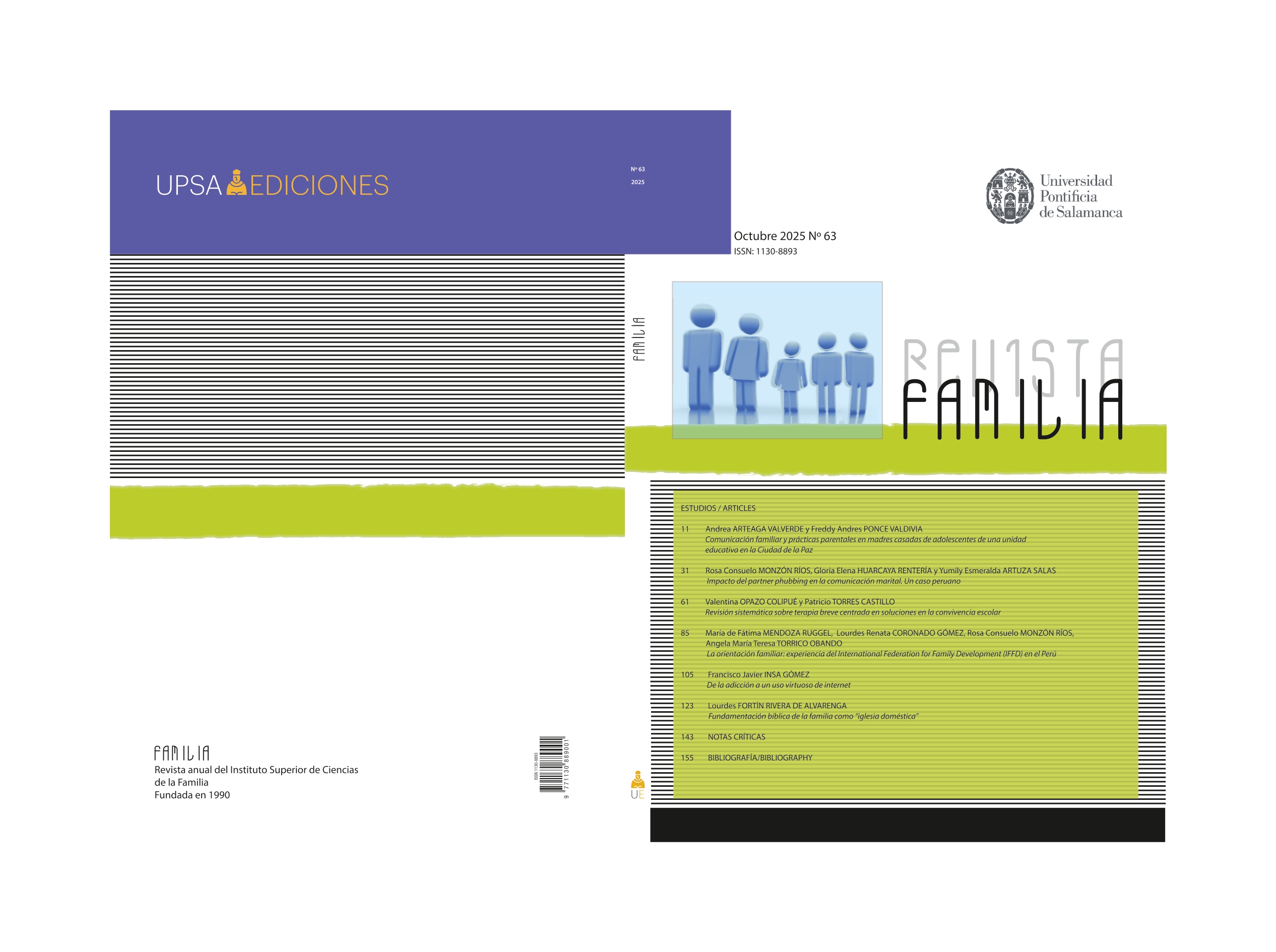Family communication and parenting practices among married mothers of adolescents at an educational institution in the City of La Paz
Main Article Content
Family constitutes the fundamental core of society, serving as the primary context for the transmission of values, the formation of emotional bonds, and the foundation of personal and social development. In this regard, examining parenting practices among married mothers is crucial, as these factors play a significant role in family dynamics and in the well-being of adolescents. This study adopts a quantitative, cross-sectional, explanatory, and descriptive design, employing instruments such as the Alabama Parenting Questionnaire (APQ), the Parent-Adolescent Communication Scale (PACS), and a brief parenting scale. Findings indicate that married mothers tend to adopt positive parenting styles, which are strongly influenced by the quality of family communication and the marital relationship. These elements foster an emotionally supportive environment for adolescents. Nonetheless, persistent challenges such as low parental supervision and inconsistent discipline remain. The study underscores the importance of promoting parenting practices grounded in affection, open communication, and shared responsibility.
Article Details
How to Cite
References
Aragón-Luna, L., Rodríguez-Sánchez, M. L., y Martínez-Ramírez, J. (2024). Madres y crianza en contextos culturales latinoamericanos. Editorial Académica.
Aranda, L., y Lemos, I. (2019). Conciliación de la vida laboral y familiar en madres trabajadoras. Revista Latinoamericana de Estudios de Familia, 11(2), 45-61.
Baumrind, D. (1971). Current patterns of parental authority. Developmental Psychology Monograph, 4(1), Pt.2. https://doi.org/10.1037/h0030372
Bowlby, J. (1969). Attachment and Loss: Vol. 1. Attachment. Basic Books.
Bowen, M. (1978). Family therapy in clinical practice. Jason Aronson.
Bronfenbrenner, U. (1979). The ecology of human development: Experiments by nature and design. Harvard University Press.
Calafat, A., García, F., Juan, M., Bina, R., y Fernández-Hermida, J. R. (2021). Which parenting style is more protective against adolescent substance use? A longitudinal
study in six European countries. Drug and Alcohol Dependence, 219, 108426. https://doi.org/10.1016/j.drugalcdep.2020.108426
Calvo Quintal, S. (2020). Prácticas parentales y bienestar psicológico en adolescentes: una revisión sistemática. Revista de Psicología y Educación, 15(2), 101-115.
https://doi.org/10.23923/rpye2020.02.192
Carrera, B., y Mazzarella, C. (2001). Vygotsky: enfoque sociocultural. Educere, 5(13), 41-44.
Chávez, M. L. (2024). La maternidad idealizada: Representaciones sociales en madres latinoamericanas. Fondo Editorial Universitario.
Galende, N., Valdivia, M., y Arranz, E. (2023). Parental involvement, communication and positive parenting: Effects on adolescent well-being. Journal of Child and Family Studies, 32, 1054-1068. https://doi.org/10.1007/s10826-023-02539-w
Gómez-Ortiz, O., Romera, E. M., y Ortega-Ruiz, R. (2020). Parenting practices and adolescent adjustment: The role of parental emotional support and communication.
Children and Youth Services Review, 110, 104791. https://doi.org/10.1016/j.childyouth.2020.104791
González, M., y López, A. (2021). Nuevas formas de maternidad y crianza: del apego a la corresponsabilidad. Cuadernos de Familia, 18(1), 33-50.
Instituto Nacional de Estadística (INE). (2017). 58 de cada 100 madres en Bolivia tienen actividad laboral. INE; Instituto Nacional de Estadística. https://www.ine.gob.bo/index.php/58-de-cada-100-madres-en-bolivia-tienenactividad-laboral/
Llorca-Mestre, A., Samper-García, P., Malonda-Vidal, E., y Vicent, M. (2021). Parenting styles and adolescent adjustment: The mediating role of emotional self-regulation. Current Psychology, 40(2), 678-688. https://doi.org/10.1007/s12144-018-9967-0
López, F., y Rojas, M. (2021). Transformaciones familiares y estilos de crianza en América Latina. Revista Iberoamericana de Psicología, 18(2), 67-84.
Martínez, J., y Ramírez, E. (2020). Parentalidad positiva y cambios culturales en la crianza: una revisión crítica. Revista de Estudios Sociales, 72, 45-60.
Nelson, S. K., Kushlev, K., y Lyubomirsky, S. (2021). The effects of marital satisfaction on parenting behavior: Evidence from dyadic and longitudinal data. Journal of Social and Personal Relationships, 38(1), 3-21. https://doi.org/10.1177/0265407520952752
Obregón, J. A., Tello, M. F., y Peña, R. M. (2020). La imagen idealizada de la maternidad en contextos urbanos. Revista Latinoamericana de Estudios de Familia, 12(1), 45-62. https://doi.org/10.22201/ife.2020.v12n1.223
Oliva, A., Parra, Á., Sánchez-Queija, I., y López-González, L. (2022). Supervision and support: Key parental behaviors in adolescence. Psicothema, 34(1), 34-41.
https://doi.org/10.7334/psicothema2021.223
Parra, Á. (2024). Desarrollo adolescente y dinámicas familiares en América Latina. Ediciones Psicológicas Andinas.
Ramírez, C., Torres, J., y Salinas, P. (2020). Estereotipos de género y maternidad: una revisión desde la equidad. Revista Interdisciplinaria de Estudios de Género, 6(3), 77-93.
Rogers, C. R. (1951). Client-centered therapy: Its current practice, implications and theory. Houghton Mifflin.
Trigo, M. S. (2024, agosto 30). De casi ocho hijos a sólo dos en 50 años: así bajó la tasa de fecundidad en Bolivia. infobae. https://www.infobae.com/america/america-latina/2024/08/30/de-casi-ocho-hijos-a-solo-dos-en-50-anos-asi-bajo-la-tasa-de-fecundidad-enbolivia/
UNFPA. (2022). Estado de la población mundial 2022: Visto, contado, incluido: Derechos y opciones para todos. Fondo de Población de las Naciones.
Unidas. https://www.unfpa.org/swop
UNICEF (2023). Maternal mortality data. https://data.unicef.org/resources/dataset/maternal-mortality-data/

